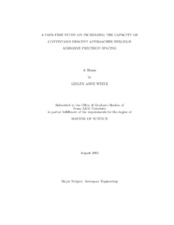| dc.description.abstract | Due to projectedincrea ses in air traffic, there are several research efforts underway
to evaluate ways to safely increase the capacity of the National Airspace System
(NAS), improve operational efficiency, andre duce aircraft noise. At NASA Langley
Research Center (LaRC) in Hampton, Virginia, two parallel research efforts have focusedon
terminal area research: one is Airborne Precision Spacing (APS), and the
other is the Quiet Aircraft Technologies (QAT) project. The APS objective is to
increase terminal-area capacity without adversely affecting safety, whereas the QAT
project objective is to develop noise- and fuel-efficient approach trajectories.
The APS project developed a cockpit tool, called Airborne Merging and Spacing
for Terminal Arrivals (AMSTAR), that issues speedco mmands to aircraft to maintain
desired spacing between aircraft pairs. The APS studies showed an ability to
increase runway capacity; however, capacity increases may negatively impact noise
andemissio n levels in airport areas. The QAT project created efficient Continuous
Descent Approaches (CDAs), which showedred uctions in aircraft ground noise and
fuel consumption. Previous research has shown that CDA trajectories have adverse
effects on runway capacity because aircraft must be spacedf urther apart at long distances
from the runway to prevent separation losses at the runway threshold. To
date, the APS and CDA concepts have been evaluated independently at LaRC.In this study, three different approaches to combining APS and CDA operations
were evaluatedto determine the feasibility and benefits of combining these concepts.
These methods combined AMSTAR with 3◦-flight-path-angle-CDA approach routes,
3◦-CDA routes with spoilers, and2 ◦-CDA routes without spoilers. Adding the use
of spoilers allowedf aster responses to large speedr eductions issued by AMSTAR.
This improvement was contrastedwith the effects of a shallower flight-path angle for
greater deceleration capabilities.
This research indicated that AMSTAR improved the performance of CDA operations,
although full capacity improvements were not achieved. Whereas the 2◦-CDA
routes were expectedto show the best results, the 3◦-CDA case with spoilers showed
the least variability in thresholdspacing errors. All of the CDA routes were more
noise, fuel, and time efficient than traditional step-descent routes that are commonly
usedto day. | en |


